| Please access the following URL if you want to secure using SSL. All pages in the site will be secure pages. |
https://secure02.blue.shared-server.net/www.fish-food.co.jp/message english 10.2023.html |
Welcome to FISH FOOD TIMES
Oct. 2023 issue No.238


Domestic farmed raw salmon
History and current status of domestic salmon farming
I got Nishimaira salmon from Miyazaki Prefecture in raw round form.

Nishimera Salmon is a one-of-a-kind salmon made by Idouchi Salmon Farm Co., Ltd. by crossing Japanese-grown Ezo char with Donaldson trout, which is one of the largest rainbow trout. As of 2022, this is one of 78 farmed salmon farms nationwide called ``local salmon.'' The table below shows a number of local salmon brands set up across the country, as announced by Minato Shimbun. (Tables will not be translated into English)
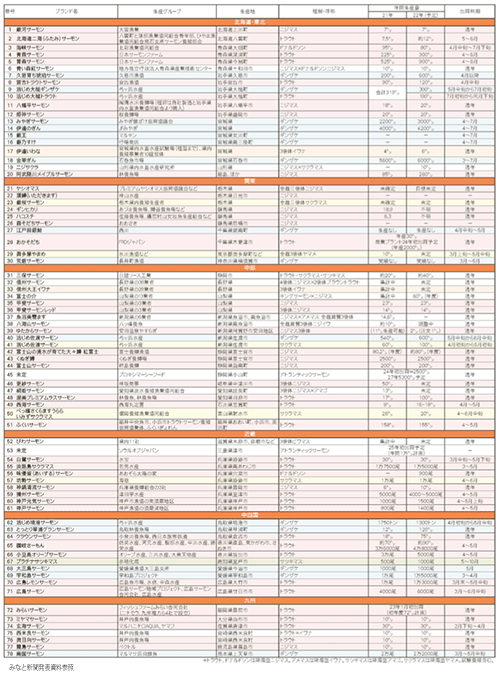
The figure below shows the current state of salmon farming in Japan as of 2018, as presented by Satoshi Imai, Aquaculture Production Group, Resource Production Department, Seto Inland Sea Fisheries Research Institute, Fisheries Research and Education Organization. This document also shows that rainbow trout, including trout, are the most commonly farmed fish species. (Figure will not be translated into English)

Rainbow trout are native to the rivers that flow into the Pacific Ocean in the western United States. (The following content regarding the history of salmon trout is referenced and summarized from materials on MARUHA NICHIRO's website SALMON MUSEUM)
Japan's salmon farming began 146 years ago in 1877 (Meiji 10) when 10,000 rainbow trout eggs were donated to Japan from North America, and at the same time, inland water farming of rainbow trout was introduced.
Following the promulgation of the ``Fisheries Propagation Encouragement Regulations'' in 1926, hatcheries and fish farms were opened in prefectures across the country, and inland aquaculture of rainbow trout became popular. Rainbow trout production reached a record high of 18,230 tons in 1982 (Showa 57), but has since declined to 8,848 tons in 2004 (Heisei 16). Salmon trout other than rainbow trout are farmed including yamame trout, amago trout, char, red trout, and coho salmon, which have been farmed for the purposes of food, recreational fish, stocking into rivers and lakes, and production of seedlings for marine aquaculture.
On the other hand, salmon trout marine aquaculture began in the late 1950s, and rainbow trout marine aquaculture trials were conducted in Hiroshima Prefecture in 1960 and Shizuoka Prefecture in 1960, but both were ended without commercialization. did. However, in 1975, the Shizugawa Fisheries Cooperative in Miyagi Prefecture successfully conducted a marine culture experiment for coho salmon, and since then, farmed coho salmon has been shipped as fresh fish to markets across the country.
Coho salmon farming reached its peak in 1991 with production reaching 26,000 tons. However, due to the import of farmed salmon trout from overseas such as Norway and Chile, fish prices declined, business benefits were lost, and production began to decline. In 1996 (Heisei 8), production fell below 10,000 tons and decreased to 8,500 tons. Although fish prices continued to decline after that, production of over 10,000 tons continued, mainly in Miyagi Prefecture, while producers made improvements such as reducing aquaculture costs. As of 2021, the total domestic production of coho salmon, including a small amount of natural products, is 18,540 tons.
As of 2021, Japan's total production of farmed salmon, including other salmon, is 22,000 tons. In the same year, 4,128,000 tons of farmed salmon were produced worldwide, and Japan had a share of only about 0.5%, ranking only 18th in the world. By far, the world's largest producer of salmon is Norway with 1,657,000 tons, followed by Chile with 995,000 tons, and the United Kingdom is third with a production of 218,000 tons, about 10 times that of Japan. In other words, Japan is in a position where it has no presence in terms of quantity in the world of farmed salmon.
Premium farmed salmon
Although the production volume of farmed salmon is low, as mentioned above, the history of salmon farming dates back 146 years, so I think that a certain amount of knowledge about salmon farming has been accumulated over almost 1.5 centuries.
For example, in July of this year, Okayama University of Science, NTT East Japan, and Fukushima Prefecture's Super Ichii jointly announced the news that ``the world's first land-based cultivation of sockeye salmon was successful.'' This can be said to shed new light on the history of salmon farming in Japan.
Until now, sockeye salmon has been considered difficult to farm due to its low resistance to disease and slow growth. However, Okayama University of Science and NTT East Group combined their own environmentally friendly water aquaculture know-how and plant systems with ICT (information and communication technology). By increasing the efficiency and automation of the work, they built the optimal equipment for land-based sockeye salmon farming. As a result, the average weight of sockeye salmon was about 70 grams when farming started in early January 2022, but in just one and a half years, the sockeye salmon have grown to an average of 800 to 900 grams, with a maximum weight of over 1,200 grams. Normally, it takes four years for sockeye salmon to grow to this size, from fry to adult fish that can be shipped.
The above expression "first in the world'' comes with the proviso "on a business basis". Already in 2019, Okayama University of Science succeeded in cultivating sockeye salmon on land for the first time in the world at the level of a demonstration experiment, and Okayama University of Science itself sold about 1,100 farmed sockeye salmon to the market. In this case, "the company that will be the sales entity made an investment with the premise of full-scale business development, and this was the first successful initiative in the world.''
There is no doubt that Japan is in a position where it has no presence in the world in terms of quantity in terms of salmon farming. I believe that in the future Japan will need to be able to establish its own unique presence from a qualitative perspective, based on the knowledge cultivated through its long history of aquaculture.
From this point of view, the Nishimera salmon that I obtained this time is a premium salmon created by Mr. Kiyoo Hamasuna, the representative of Idouchi Fish Farm in Miyazaki Prefecture, by crossing Japanese-grown Ezo char and Donaldson trout. This process reportedly took about 20 years. This salmon is expected to be qualitatively differentiated from other farmed salmon.
The Nishimera salmon
Now, let's introduce the process of commercializing this premium Nishimera salmon and the finished product.
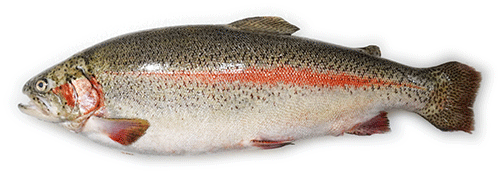
This image shows the state after the scales were removed. When the fish's scales were removed, the red band-like markings on the side of the fish's body stood out clearly and vividly. If the band-shaped markings are bright red like this, you can judge that the fish is fresh.
| Bonus of fish roe came out during the belly removal process. | |
|---|---|
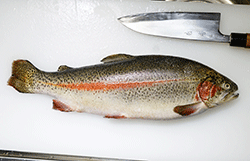 |
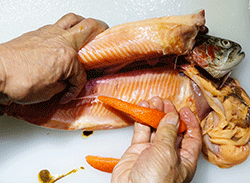 |
| 1,After removing the scales, turn the head. | 5,Handling the fish gently, as if handling a baby, first and foremost, remove the roe and then remove the internal organs. |
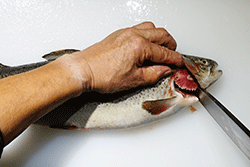 |
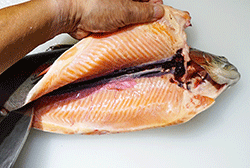 |
| 2,First, cut the gill membrane and then the base of the jaw. | 6,Make a cut in the relatively large chiai with the tip of the knife. |
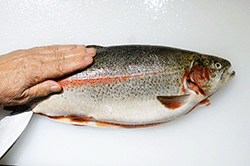 |
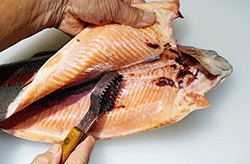 |
| 3,Make a vertical incision in the abdomen, past the anus, and proceed to the edge of the anal fin. | 7,Use the back of the scale remover to completely remove the chiai. |
 |
 |
| 4,Fortunately, when the abdomen was opened, valuable fish eggs came out. I did not specify the condition that the fish be female. | 8,腹出し処理を終えた魚体と魚卵。 |
Failure... Making salmon roe that I shouldn't have done
Luckily, even though I hadn't specified it as a female, fish eggs came out of its belly. But her joy was short-lived. When I started making salmon roe, my joy completely disappeared and I realized that I should have made sujiko instead.
| Process of making salmon roe pickled in soy sauce from farmed salmon | |
|---|---|
 |
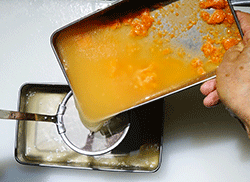 |
| 1,Place the removed fish eggs in a vat and pour lukewarm, lightly salted water into it. | 5,Place the partially loosened fish roe in a mesh ladle and discard the cloudy thin salt water. |
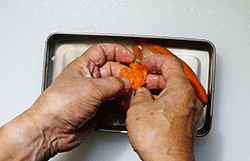 |
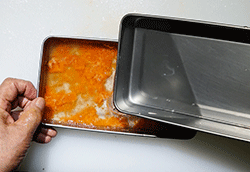 |
| 2,First, I tore the membrane covering the fish eggs and began the process of carefully removing the eggs from inside without crushing them. | 6,Add fresh salt water to the remaining fish eggs in the vat. |
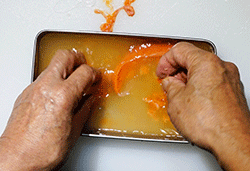 |
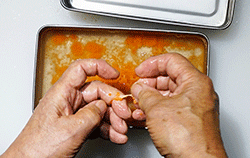 |
| 3,The roe of farmed salmon was full of fat, unlike wild salmon. These were slippery and very small in size. Because of this, it was very difficult to remove the eggs from the egg sacs. | 7,I continued to remove the eggs in the lightly salted water. I had to do the same thing over and over again to remove the white mucous membrane, but it was a very nerve-wracking task to avoid crushing the eggs. |
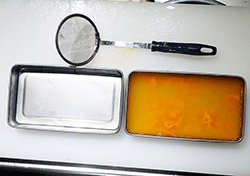 |
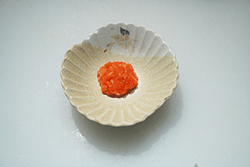 |
| 4,Prepare another bat and a mesh ladle. | 8,This process took over 30 minutes, and I finally drained the water and placed it in a small bowl. |
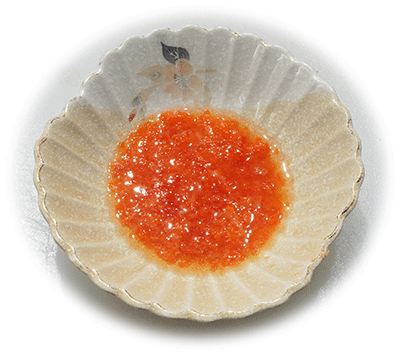 |
|
| Finally, soy sauce, sake, and mirin are added to complete the farmed salmon salmon roe pickled in soy sauce. | |
Making this pickled salmon roe in soy sauce was really difficult... Many times I wanted to give up and think, ``I shouldn't have done this.'' I approached this with the same feeling of making autumn salmon, salmon roe pickled in soy sauce, and it was a big mistake. In any case, my fingers get sticky with the fat as I work, and the fish eggs are so small that I can't tell which one is which. I really wanted to stop working halfway through, but I didn't give up and finally finished it. However, as shown in the image above, only a small amount of salmon roe can be harvested. Some readers may laugh and say, "Are you a simp?", but for those who don't, I hope you will use my bitter experience when you encounter a similar situation.
I decided not to eat the salmon roe pickled in soy sauce that was completed in this way. I decided to use it in a way similar to ``ashirai'' to increase the commercial value of Nishimera salmon, and to console myself for my painful hardships. I would like to comment on this later when it is commercialized.
Not very hard bones unique to salmon
Next is the three piece disassembling process for Nishimera salmon. It's not like they dismantled it in any particularly unusual way. However, in order to show what kind of physical state it was in, and since I believe that our readers are not all veterans with advanced knife skills, I will introduce the process without omitting the details for those who are not veterans. If you don't have a lot of time and want to avoid the obvious parts, you can feel free to skip ahead.
| The three pieces disassembling process for Nishimera salmon. | |
|---|---|
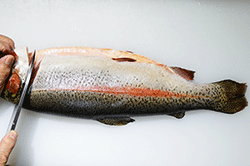 |
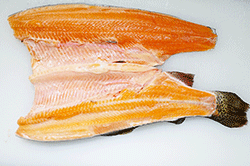 |
| 1,Make a cut at the base of the head on the lower body side. | 7,Finished until two pieces disassembling. |
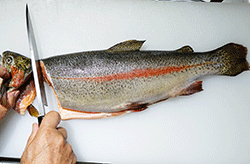 |
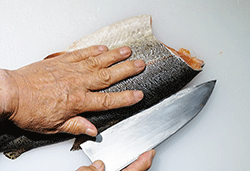 |
| 2,Make a cut at the base of the head on the upper body side and separate the head. | 8,The bones of raw salmon are not hard, so be careful with the knife after this step or you may end up slicing the centralbone. The trick to not cutting into the bones is to use a wide range of hasaki, including the sori of the knife, and avoid using kittusaki too much. |
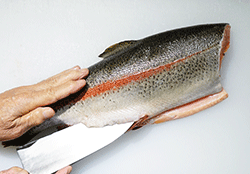 |
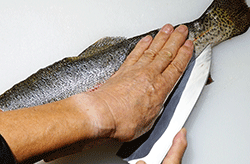 |
| 3,Make a cut on the edge of the anal fin on the lower body side, and continue cutting until you reach the backbone. | 9,Make a cut at the edge of the anal fin on the upper body side and continue cutting all the way to the backbone. |
 |
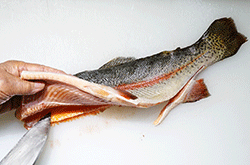 |
| 4,Make a cut on the dorsal fin edge on the lower body side, and continue cutting until you reach the backbone. | 10,Separate the belly bone near the head by raising the knife toward you and using a hasaki motion to cut it. If you force yourself to do this and move the knife from the tail to the head, the meat will crack. |
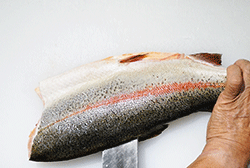 |
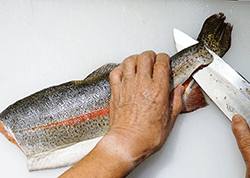 |
| 5,Cut along the backbone with the knife from the tail side toward the head side. | 11,Separate the connected part at the base of the caudal fin. |
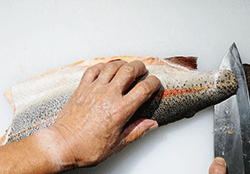 |
 |
| 6,Separate the connected part at the base of the caudal fin. | 12,Three pieces disassembling is completed. |
Yield rate of Nishimaira Salmon Trim C
Now, we have finished up to Three pieces disassembling. However, the fresh Atlantic salmon that is routinely flown in from Norway at the Fisheries Department work site is probably in Trim C or Trim E condition, placed in vacuum bags. I think that from that state, they often work to commercialize it into sashimi, sushi, fillets, etc.
Even if they were to butcher raw salmon, I think most people would only have experienced semi-dressed salmon with the gills and internal organs removed, rather than the round shape. I think it is not very common to disassemble farmed salmon from the raw round state that the author did this time.
Therefore, I decided to see what the yield rate would be if I put the Nishimera Salmon in the condition of this round into a condition similar to Norwegian Atlantic Salmon Trim C. However, since the author accidentally removed the pelvic fin and pinbone, the yield rate is thought to be slightly lower than Trim C of air-fed Atlantic salmon.
| Nishimaira Salmon Trim C | |
|---|---|
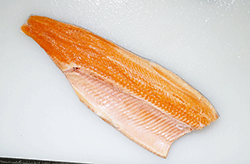 |
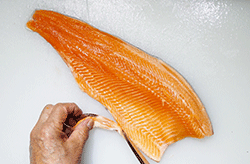 |
| 1,The upper half of the body is in a state of three pieces disassembling. | 4,Remove the pelvic fin (not done in Trim C) |
 |
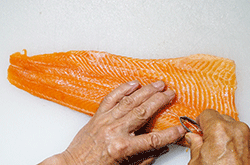 |
| 2,Remove belly bone. | 5,Remove the pin bone (not done with Trim C) |
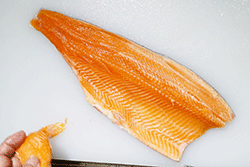 |
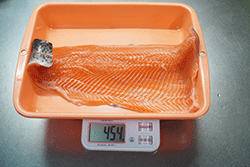 |
| 3,Remove even the thin skin of the abdominal cavity. | 6,Half body weight is 454g |
In this way, I did something a little different from the original form of Trim C, but when I measured the half body, it weighed 454g. If you simply double this as 2 pieces, it becomes 908g. Since the original weight of the Nishimaira Salmon Round was 1.7 kg, the yield rate was calculated to be 53.4%. Let's compare it with other farmed fish with skin and without belly bone, which was made by three pieces disassembling. Ignoring aspects that are affected by seasonal factors, and using common sense experience, for example, farmed red sea bream has a yield rate of 35%, and farmed yellowtail has a yield rate of about 45%, so the yield rate of Nishimera salmon is relatively good numerical value.
The Nishimaira salmon that I purchased this time contained female roe, so the weight of the internal organs must be relatively large, and the yield is considered to be less favorable than that of males. Moreover, even after removing the pelvic fin and pin bones, the yield rate is still 53.4%, so it can be seen as an extremely excellent level from a yield point of view.
Regarding the purchase price of Nishimera salmon, I would like to refrain from disclosing it here because there are probably various situations and positions of the companies that purchase it for business. Well, I just want to say that you can consider that the price is almost the same as the raw Atlantic Salmon Trim C flown in from Norway that you usually buy.
Let's assume that Nishimera salmon and air-freighted raw Atlan salmon are available at similar prices. Now, which would you rather sell: the air-freighted raw Atlan salmon, which takes about 10 days to be transported from Norway to stores across Japan, or the premium farmed salmon, which is produced domestically and takes time and effort?
Up until now, it has been difficult to purchase fresh farmed salmon for sashimi from sources other than Norway. However, judging from the recent momentum of local salmon in Japan, there seems to be a ray of light that will allow us to escape from the situation where we are forced to comply with Norway's orders.
Commercialization of Nishimaira salmon
Now, let's introduce some examples of commercialization of Nishimera salmon, which may be a bright spot in breaking away from Norway's dependence on raw salmon, to increase its value as a premium farmed salmon.
The next step was to remove the skin, and since there was plenty of subcutaneous fat, I was able to remove the skin very easily.
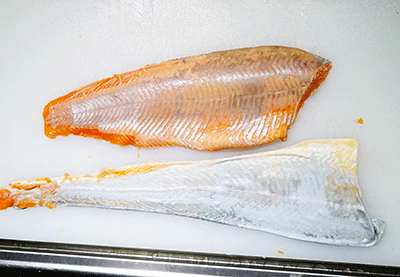
In the case of air-fed raw Atlantic salmon, the fishy odor of the chiai meat part is very worrisome, perhaps because it has been about 10 days since it was caught in Norway. Raw salmon is now said to be the most popular sushi sauce in Japan, surpassing tuna, but even so, there are still a considerable number of people who dislike salmon. The first reason people don't like salmon seems to be the fishy smell, which is something they share with people who don't like seared bonito, and in both cases, the root cause is that the chiai meat is left in without being removed.
I have been recommending that fish counters that use frozen salmon for sashimi switch to the higher-value fresh salmon. In this case, I have recommended shaving and removing the chiai meat from raw salmon as a way to make a clear difference. Although it depends on the freshness of the raw salmon, this will at least reduce the fishy smell. And even if the yield rate is lower and costs are higher because of the reduced quality, I have always said that if sashimi and sushi made with raw salmon, which does not have a fishy smell, becomes more popular, this will contribute to sales.
However, with this Nishimera salmon, the chiai meat was not shaved like imported raw Atlantic salmon. This is because the Nishimera salmon that I purchased had clearly been landed at a farm the day before, and it was extremely fresh.
If you can purchase local domestic salmon while counting back the number of days based on traceability, there is nothing more reassuring in terms of freshness. Since there is no need to cut chiai meat due to its fishy smell, the yield rate does not decrease and the cost can be reduced.
Examples of commercialization using extremely fresh Nishimaira salmon are as follows. I have omitted the work process for sashimi and sushi, and have only commented on the key points.
| Commercialization example of Nishimaira salmon |
|---|
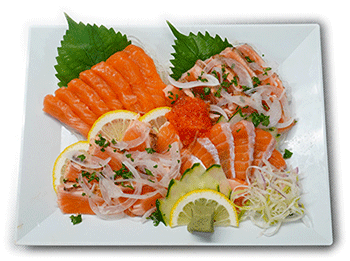 |
1,Salmon centric dish assorted sashimi Hiratsukuri sashimi uses the back body, and usutukuri sashimi uses the belly body. The seared sashimi is topped with onion slices and finely chopped parsley. The center of the sashimi is served with homemade salmon roe pickled in soy sauce. |
 |
2,Salmon centric dish assorted sushi The top row is back body nigiri sushi. In the middle is a belly-bodied seared nigiri sushi topped with onion slices, mayonnaise, and finely chopped parsley. On the left side of the bottom row, a prismatic maki core is rolled into thin rolls, and on the right side of the bottom row, salmon scraps from the commercialization process are made into large servings of gunkan sushi. |
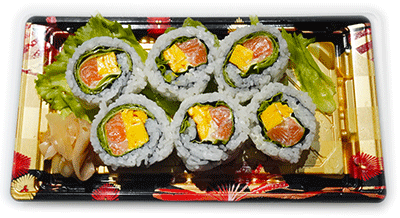 |
3,Raw salmon uramaki sushi The amount of rice was about 200g, and the core of the roll was filled with salmon, dashimaki egg, and lettuce. Lettuce is also placed under the uramaki to add color. Due to the container, I decided to cut it into 6 pieces so that it didn't give the impression that it was packed too tightly. |
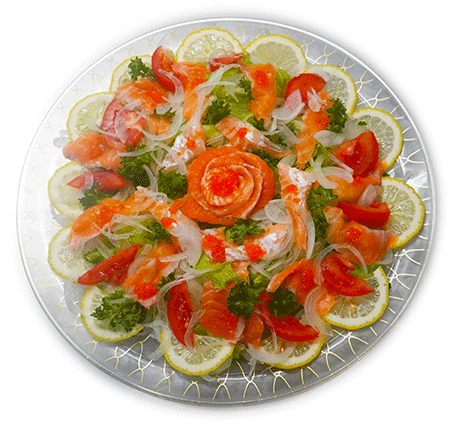 |
4,Salmon carpaccio salad I spread torn lettuce all over the bottom of a round container, added onion slices and parsley, and arranged cherry tomatoes and lemon slices in a circle. Then, the thinly sliced salmon was placed in an appropriate manner, and the salmon rosette was placed in the center, finally, the homemade salmon roe pickled in soy sauce was sprinkled in the center and throughout the roses. |
The final product to be commercialized is a dish made with salmon heated.
| Salmon and eggplant marinated in flavored sauce | |
|---|---|
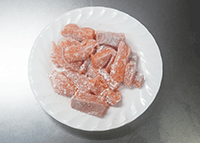 |
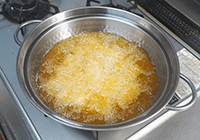 |
| 1,Cut the salmon into 3x6cm cubes, season with salt and pepper, and sprinkle with flour. | 5,Fry the salmon until it changes color. |
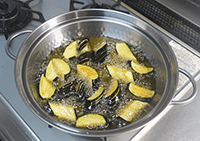 |
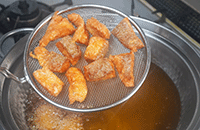 |
| 2,Cut the eggplant in half lengthwise, make a diagonal cut, cut into bite-sized pieces, and fry in oil at 170°C until lightly colored. | 6,Fry until well colored, then remove from the oil. |
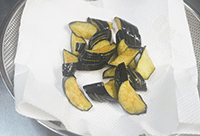 |
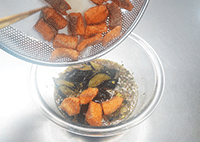 |
| 3,Eggplant that is fried until it changes color. | 7,Add the fried salmon to the flavored sauce. |
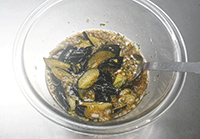 |
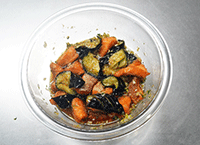 |
| 4,Soak the eggplant in the flavor sauce (4 tablespoons each of soy sauce, vinegar, and sugar, 2 tablespoons each of water, sesame oil, and 1/2 tablespoon of lemon juice) for at least 15 minutes. | 8,Mix the flavored sauce and salmon, let cool to room temperature, then serve on a plate. |
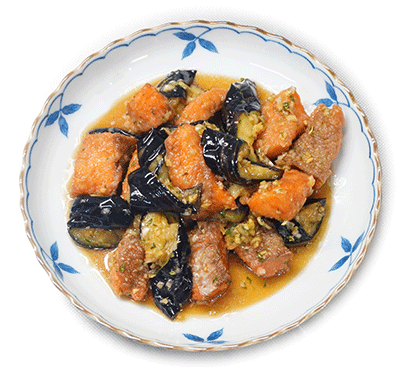 |
|
| Salmon and eggplant marinated in flavored sauce that is delicious even when cold and lasts for a long time | |
The rise and fall of salmon farming
As of the end of September 2023, the exchange rate of the yen is in the 149 yen range to the dollar, and there is a possibility that it will fall to the 150 yen level, a weak yen is becoming the norm. Unless there is a significant change in the world situation, it is basically predicted that the yen's exchange rate against the dollar will not see a major change to the 100-110 yen range, as it has in the past.
Considering this situation, the price of imported salmon from Norway, which has been relied upon in the food world including the seafood industry, will remain high due to the weak yen, and there is no hope that it will be purchased cheaper in the future. . In that case, the existence of local salmon, such as the Nishimera salmon, which is the theme of this month's issue, may be a savior for the industry in a sense.
From the perspective of salmon farmers, the cost of operation and maintenance, such as the feed and electricity costs necessary for aquaculture, is soaring, and it may not be possible to do it that cheaply. However, I would like to hope that local salmon businesses will come up with a system that will somehow eliminate the need to rely on imported salmon.
When I was an elementary school student more than 60 years ago, I remember seeing a rainbow trout fish farm up close with my own eyes in a remote mountain area. However, before he knew it, the fish farm had disappeared. Tracing the history of farmed fish in Japan, it appears that although the farmed fish business started 146 years ago, it has gone through ups and downs, with attempts at salmon farming not working out and the business closing down. However, large companies from other fields, including JR and NTT, are now investing in salmon farming one after another, and the salmon farming industry seems to be booming again.
We would be very welcome if a large company in a different field with stable sales and profits could help us get the salmon farming business in Japan back on track. Salmon is the most popular fish after all, so large companies are probably taking this initiative based on their research and analysis showing that there is still a large demand for it.
If people involved in the sale of seafood products can purchase imported salmon and domestic salmon at the same price, I would like them to give priority to purchasing domestic salmon. I hope that they will make efforts to support the local salmon business through this.
| Please access the following URL if you want to secure using SSL. All pages in the site will be secure pages. |
https://secure02.blue.shared-server.net/www.fish-food.co.jp/message english 10.2023.html |
An opinion and the communication are to iinfo@fish food times
Date of updating 1 Oct. 2023
